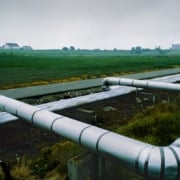U.S. Department of Transportation Publishes Final Rule on State Greenhouse Gas Performance Measures
On December 7, U.S. Department of Transportation Federal Highway Administration (FHWA) published a final rule providing state Departments of Transportation (DOTs) and Metropolitan Planning Organizations (MPOs) a national framework to track transportation-related greenhouse gas (GHG) emissions and set targets for reduction. The rule adds a new GHG performance management measure to the existing FHWA national performance measures and creates a system under which state DOTs and MPOs must set targets for reducing roadway travel GHG emissions. Stakeholders that contract with states to build infrastructure should take note of these new mandates.
The rule requires states to establish initial two- and four-year statewide GHG reduction targets and report those goals to FHWA by February 1, 2024. Subsequent targets must be established and reported by October 1, 2026. MPOs must establish four-year GHG reduction targets for their metropolitan planning areas, and certain MPOs serving urbanized areas with populations of 50,000 or more must establish additional joint targets.
The performance period for the first four-year target is measured retroactively from January 1, 2022, through December 31, 2025. States are required to calculate and report tailpipe carbon emission metrics for a given year in millions of metric tons. MPOs are granted flexibility in calculating the metrics, but the rule “encourage[s]” MPOs to coordinate with their state DOTs “to the maximum extent practicable.”
FHWA estimates the total cost of complying with this rule will be substantial — approximately $10.8 million from 2023 to 2032. However, there will be access to federal funding, as the Bipartisan Infrastructure Law (BIL) includes $27 billion in funding across various programs that federal agencies may use to support GHG emission reduction projects. These include the following:
- The Carbon Reduction Program provides $6.4 billion in formula funding to state and local governments to develop carbon reduction strategies and fund projects — including eligible assets owned by local governments, counties, and tribes — designed to reduce carbon emissions from on-road highway sources.
- The National Electric Vehicle Infrastructure formula program provides $5 billion to states, primarily through a statutory formula, to build out a national electric vehicle charging network.
- The Charging and Fueling Infrastructure discretionary grant program provides $2.5 billion in competitive funding to states, local governments, and tribes to deploy electric vehicle charging and hydrogen, propane, and natural gas fueling infrastructure along designated alternative fuel corridors and in communities.
- The Congestion Relief Program provides $250 million in competitive funding to advance innovative, multimodal solutions to reduce congestion and related economic and environmental costs in the most congested metropolitan areas of the U.S.
- The Reduction of Truck Emissions at Port Facilities Program provides $400 million in competitive funding to reduce truck idling and emissions at ports, including through the advancement of port electrification.
- The Low or No Emission Vehicle Program provides $5 billion to replace transit buses with zero emission electric buses and other low- or zero-emission technologies.
- The Transportation Alternatives Set-Aside Program provides $7.2 billion to help state and local governments carry out environmentally friendly pedestrian and bicycle infrastructure projects.
- The Transit Oriented Development (TOD) Program provides $69 million in funding to local communities to integrate land use and transportation planning with new fixed guideway or transit capital investment projects. BIL also expands TOD financing opportunities through the Transportation Infrastructure Finance and Innovation Act and Railroad Rehabilitation & Improvement Financing programs.
In short, significant federal money is available to provide funding to help states meet the new GHG reduction targets. Moreover, states will have the flexibility to pursue different projects to address carbon emissions including substantial funding for investment in public transportation. These funds will provide essential support to state governments efforts to meeting these GHG emissions reduction targets.
This post is as of the posting date stated above. Sidley Austin LLP assumes no duty to update this post or post about any subsequent developments having a bearing on this post.


